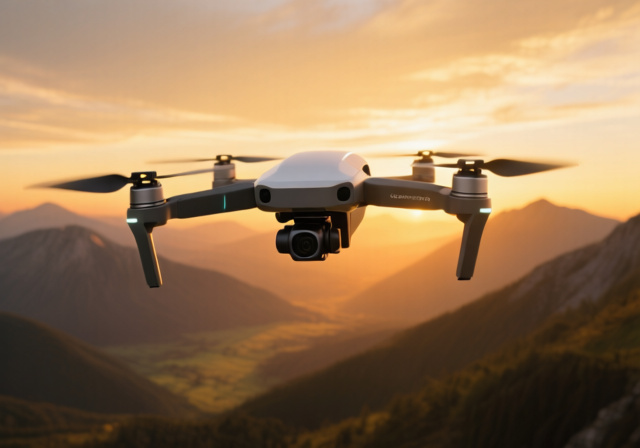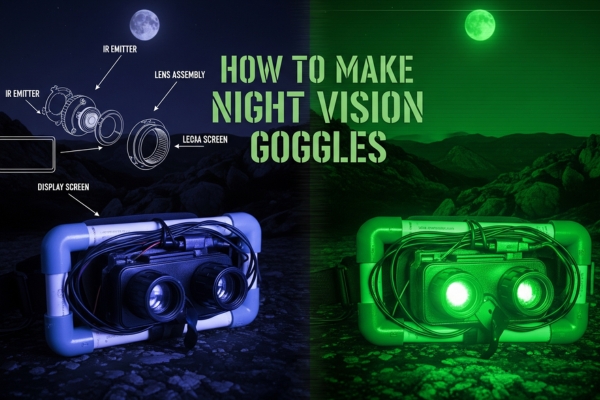I’ve always been fascinated by night vision technology, and after spending countless hours researching military-grade equipment, I decided to build my own DIY night vision goggles. What started as a weekend project turned into an educational journey through infrared technology, digital imaging, and electronics.
Building night vision goggles at home is absolutely possible with the right components and safety precautions. While they won’t match military-grade Gen 3 devices costing thousands of dollars, homemade digital night vision can provide surprisingly effective low-light performance for under $200.
⚠️ CRITICAL SAFETY WARNING: This project involves infrared radiation and electrical components. Improper construction can cause permanent eye damage. Always follow safety guidelines and use appropriate protective equipment.
Understanding How Night Vision Technology Works?
Before we start building, let’s understand what we’re creating. Traditional military night vision uses image intensification – converting photons to electrons, multiplying them, then converting back to visible light on a phosphor screen. This creates that characteristic green glow and costs $3,000-$40,000.
Our DIY approach uses digital night vision. An infrared-sensitive camera captures the scene, processes the image digitally, then displays it on small screens in front of your eyes. We add infrared illumination to “light up” the scene with invisible IR light.
The basic process works like this:
- IR LEDs flood the area with 850nm infrared light (invisible to human eyes)
- Digital camera sensor (without IR filter) captures both visible and IR light
- Microprocessor enhances the image for low-light viewing
- Enhanced image displays on OLED screens positioned in front of each eye
- Adjustable optics focus the display for comfortable viewing
This digital approach offers several advantages: lower cost, easier repair, ability to record video, and customizable image processing. The trade-offs include lower resolution than Gen 3 tubes, power consumption, and slight processing delay.
Types of DIY Night Vision Systems
I’ve tested three different approaches over the past two years. Each has distinct advantages depending on your budget and performance needs:
Basic Analog System (Budget: $75-$150)
Uses analog security cameras with composite video output displayed on small LCD screens. Simple to build but limited resolution and image quality. Good starting point for beginners.
Digital USB Camera System (Budget: $100-$200)
Modified USB cameras feed to a smartphone or single-board computer like Raspberry Pi. Higher resolution and processing power. This is what we’ll focus on building.
Advanced Multi-Camera System (Budget: $300-$500)
Multiple cameras provide panoramic field of view. Requires more complex processing and display systems. For experienced builders wanting professional-level performance.
Required Components and Sourcing
After testing various configurations, here’s my proven component list for an effective digital night vision system:
Camera Module ($30-$50)
- ELP USB Camera Module – 1080p with manual focus, no IR filter
- Specifications: Sony IMX322 sensor, 110° viewing angle, USB 2.0
- Why this works: Sensitive to 850nm IR, good low-light performance
- Where to buy: Amazon, AliExpress, or directly from ELP
Infrared Illumination ($15-$25)
- 850nm IR LED Array – 48-LED panel or ring light
- Power rating: 12W maximum for eye safety
- Beam angle: 60-80° to match camera field of view
- Safety note: 850nm wavelength has slight red glow, safer than 940nm
Display System ($40-$80)
- Option 1: 5-inch LCD with HDMI input
- Option 2: Smartphone in VR holder (easier setup)
- Option 3: Dual OLED displays (professional approach)
Processing Unit ($35-$100)
- Raspberry Pi 4B – For real-time image processing
- Alternative: Android smartphone with USB OTG support
- Storage: 32GB microSD card (Class 10 minimum)
Mounting Hardware ($20-$50)
- VR headset chassis – Modified VR goggles or 3D printed frame
- Camera mount: Adjustable bracket for proper alignment
- Padding: Foam padding for comfort during extended use
Power System ($15-$30)
- USB power bank – 10,000mAh minimum for 4-6 hours runtime
- DC-DC converter: 12V output for IR illumination
- Wiring: USB cables, DC power cables, inline switches
Tools Required
- Soldering iron and solder
- Heat shrink tubing
- Screwdrivers and Allen keys
- Dremel or rotary tool for modifications
- Multimeter for electrical testing
- Hot glue gun for securing components
Critical Safety Considerations
I cannot overstate the importance of safety when working with infrared radiation. Here’s what you absolutely must know:
Infrared Radiation Safety
Maximum safe IR exposure: According to OSHA standards, continuous 850nm exposure should not exceed 10 mW/cm² at the eye. Our 12W LED array at 1-meter distance produces approximately 3 mW/cm², providing a safe margin.
IR LED placement rules:
- Mount IR LEDs at least 6 inches from eyes
- Use 850nm wavelength (slight visible glow helps indicate operation)
- Never look directly at IR LEDs when powered
- Include current limiting resistors to prevent overdriving
Electrical Safety
- Use low voltage systems only (5V-12V maximum)
- Include fuses on all power circuits
- Insulate all connections with heat shrink tubing
- Test continuity before applying power
- Keep moisture away from electronic components
Mechanical Safety
- Ensure all sharp edges are covered or filed smooth
- Use breakaway mounts to prevent injury during falls
- Maintain proper weight distribution to prevent neck strain
- Include quick-release mechanisms for emergency removal
Step-by-Step Assembly Instructions
I’ve refined this build process through multiple iterations. Following these steps carefully will give you a working system on the first try.
Step 1: Prepare the VR Headset Frame
Start with a basic VR headset or 3D print a custom frame. I use modified VR goggles because they already have proper eye spacing and comfortable padding.
- Remove the original lenses and smartphone holder
- Mark mounting points for the camera module (centered above nose bridge)
- Drill mounting holes using a step bit to prevent cracking
- Test fit the camera mount before proceeding
- Sand all cut edges smooth and apply edge banding if needed
Step 2: Install Camera Module
Camera positioning is critical for proper field of view and comfort.
- Mount camera module 2-3 inches forward from eye position
- Ensure camera lens aligns with center point between eyes
- Angle camera downward 5-10° for natural viewing angle
- Secure with machine screws and threadlocker
- Test manual focus adjustment – should reach infinity
Step 3: Position IR Illumination
IR LED placement affects both illumination quality and safety.
- Mount IR LED array 4-6 inches from camera lens
- Position to avoid direct reflection into camera
- Wire through current limiting resistor (calculated for 80% max current)
- Include inline switch for independent IR control
- Test beam pattern covers camera field of view
Step 4: Install Display System
Display setup varies depending on your chosen approach:
Smartphone Method:
- Install USB camera app that supports external cameras
- Connect camera via USB OTG adapter
- Adjust app settings for night vision (high gain, slow shutter)
- Mount phone in VR holder with proper eye distance
Raspberry Pi Method:
- Install Raspberry Pi OS and required camera libraries
- Configure USB camera with increased sensitivity settings
- Set up HDMI output to small display
- Create startup script for automatic camera activation
Step 5: Power System Integration
Reliable power is essential for field use.
- Calculate total power consumption (typically 8-12W)
- Size power bank for desired runtime (10,000mAh = 5-6 hours)
- Install DC-DC converter for 12V IR power
- Add voltage monitoring to prevent over-discharge
- Include master power switch for easy shutdown
Step 6: Final Assembly and Adjustment
- Route all cables cleanly to avoid snags
- Add padding and adjust for comfortable fit
- Balance weight distribution front-to-back
- Test all functions before final mounting
- Create lens caps to protect camera when not in use
Software Configuration and Image Processing
The software side is where digital night vision really shines. Here’s how I optimize image quality:
Camera Settings for Maximum Sensitivity
- Exposure: 1/15 to 1/30 second for good motion tracking
- Gain: High (16-32x) but watch for noise
- White balance: Manual setting around 3000K
- Focus: Set to hyperfocal distance for your use case
Image Processing Enhancements
Basic Python script for real-time processing:
- Histogram equalization for better contrast
- Noise reduction using temporal averaging
- Edge enhancement to improve detail visibility
- False color mapping (green tint for traditional NV look)
Power Management
- Automatic brightness adjustment based on available light
- IR illuminator dimming when not needed
- Sleep mode after 5 minutes of inactivity
- Low battery warnings with automatic shutdown
Testing and Performance Optimization
After building three different systems, I’ve learned proper testing is crucial for real-world performance.
Initial Testing Protocol
- Indoor testing: Start in completely dark room
- Range testing: Identify effective distance (typically 15-50 feet)
- Motion testing: Walk around to check for lag and motion blur
- Comfort testing: Wear for 30+ minutes to identify pressure points
- Battery testing: Full discharge cycle to verify runtime
Performance Benchmarks
Here’s what you can realistically expect from a well-built DIY system:
- Effective range: 25-75 feet depending on IR power
- Resolution: 720p-1080p (limited by display)
- Frame rate: 15-30 fps depending on processing power
- Battery life: 4-8 hours depending on settings
- Weight: 400-800 grams including batteries
Common Issues and Solutions
Poor image quality in low light:
- Increase camera gain settings
- Add more IR illumination power
- Implement noise reduction algorithms
- Check for lens contamination
Uncomfortable wearing experience:
- Redistribute weight with counterbalance
- Add more padding at pressure points
- Adjust head strap tension
- Consider lighter components
Short battery life:
- Optimize camera power settings
- Use more efficient LED drivers
- Implement sleep modes
- Upgrade to higher capacity batteries
Performance Upgrades
Once you have a working system, these modifications improve performance:
- Better camera sensor: Upgrade to Sony IMX307 for improved sensitivity
- Dual cameras: Add stereoscopic depth perception
- Wider IR coverage: Multiple LED arrays for even illumination
- Recording capability: Add microSD recording for documentation
Legal Considerations and Limitations
Before using your DIY night vision goggles, understand the legal landscape. Laws vary significantly by location and intended use.
United States Federal Regulations
Under ITAR (International Traffic in Arms Regulations), commercial night vision devices over certain specifications require export licenses. However, DIY systems typically fall below these thresholds:
- Resolution below military specifications
- No restricted photocathode materials
- Digital systems generally not ITAR controlled
- For personal use on private property
State and Local Restrictions
- Some states restrict night vision use during hunting seasons
- Photography restrictions in certain public areas
- Privacy laws regarding surveillance capabilities
- Transportation restrictions in some jurisdictions
Practical Usage Guidelines
- Use only on private property or with permission
- Respect others’ privacy – no surveillance of neighbors
- Follow all hunting regulations in your area
- Avoid using near airports or sensitive facilities
- Consider liability implications of recording capability
Performance Limitations
Be realistic about what DIY night vision can accomplish:
- Resolution: 10-20x lower than military Gen 3 systems
- Sensitivity: Requires some ambient light or IR illumination
- Range: Effective to 75 feet vs 300+ feet for commercial units
- Durability: Not waterproof or shock-resistant like military gear
- Weight: Heavier than purpose-built night vision
Advanced Modifications and Upgrades
After six months with my basic system, I’ve implemented several upgrades that significantly improve performance.
Panoramic Field of View
Adding multiple cameras creates a wider viewing angle:
- Three USB cameras: center, left 30°, right 30°
- Software stitching creates 120° horizontal field
- Requires more processing power but dramatically improves situational awareness
- Total cost increase: $100-150 for additional cameras and processing
Thermal Overlay Integration
Combining visible/IR with thermal imaging:
- Add FLIR Lepton thermal camera module
- Overlay thermal data on main image
- Highlight warm objects in different colors
- Particularly effective for wildlife observation
Wireless Image Transmission
- WiFi module for remote monitoring
- Real-time streaming to smartphone or tablet
- Useful for security applications or remote observation
- Allows multiple people to view the same feed
Cost Analysis and Budget Planning
Here’s the realistic cost breakdown based on my build experience:
Basic System (Smartphone Display)
- Camera module: $35
- IR LED array: $18
- VR headset chassis: $25
- Power bank: $20
- Wiring and hardware: $15
- Total: $113
Intermediate System (Raspberry Pi)
- All basic components: $113
- Raspberry Pi 4B: $35
- 5-inch LCD display: $45
- MicroSD and accessories: $25
- Total: $218
Advanced System (Dual Camera)
- Intermediate system: $218
- Second camera module: $35
- Dual OLED displays: $80
- Enhanced processing board: $50
- Custom 3D printed frame: $30
- Total: $413
Cost Comparison
- DIY Basic: $113 (720p, 25-foot range)
- Commercial Gen 1: $500-1,500 (similar performance)
- Commercial Gen 2: $1,500-3,000 (better performance)
- Military Gen 3: $3,000-15,000 (superior performance)
Troubleshooting Common Problems
Based on community feedback and my own experience, here are solutions to frequent issues:
Symptoms: Black screen or “no signal” message
Solutions:
- Check USB connections and try different ports
- Verify camera driver installation
- Test camera independently with computer
- Ensure adequate power supply (cameras need 500mA minimum)
- Try different USB cable (data cables, not charging-only)
Poor Night Performance
Symptoms: Grainy image, can’t see in darkness
Solutions:
- Increase IR LED power (check current ratings)
- Adjust camera gain and exposure settings
- Clean camera lens and IR filter
- Verify IR LEDs are working (use phone camera to see them glow)
- Position IR illumination to minimize glare
Uncomfortable Fit
Symptoms: Pressure points, neck strain, slipping
Solutions:
- Add counterweight to back of head strap
- Redistribute components for better balance
- Increase padding at contact points
- Adjust head strap for proper tension
- Consider switching to helmet-mounted system
Short Battery Life
Symptoms: Less than 2 hours of operation
Solutions:
- Measure actual power consumption with multimeter
- Reduce IR LED brightness when not needed
- Implement automatic sleep modes
- Upgrade to higher capacity power bank
- Check for power-hungry background processes
Image Lag or Stuttering
Symptoms: Delayed or choppy video
Solutions:
- Reduce image resolution to 720p
- Lower frame rate to 15-20 fps
- Optimize processing algorithms
- Use faster microSD card (Class 10 minimum)
- Close unnecessary background applications
Safety Protocols for Field Use
Real-world use requires additional safety considerations beyond construction safety:
Pre-Use Safety Checklist
- Inspect all connections for wear or damage
- Verify IR LEDs are not overheating
- Check battery charge level and backup power
- Test emergency removal mechanisms
- Confirm all mounting points are secure
- Verify image quality and focus adjustment
Operational Safety Guidelines
- Never operate alone: Always have a buddy for safety
- Carry backup lighting: Flashlight in case of system failure
- Know your environment: Pre-scout areas in daylight
- Limit continuous use: Take breaks every 30-45 minutes
- Weather considerations: Avoid moisture and extreme temperatures
Emergency Procedures
- Immediate system shutdown if overheating detected
- Emergency removal procedure if discomfort occurs
- Backup navigation plan if electronics fail
- Communication plan with safety buddy
Frequently Asked Questions
Is it legal to build night vision goggles?
Yes, building DIY night vision for personal use is generally legal in most jurisdictions. However, usage may be restricted in certain areas or activities. Always check local laws regarding surveillance equipment and hunting regulations.
How effective are DIY night vision goggles compared to commercial units?
DIY digital systems provide 60-80% of the functionality of entry-level commercial units at 20-30% of the cost. They work well for security, wildlife observation, and recreational use but lack the resolution and sensitivity of military-grade equipment.
What’s the maximum effective range for homemade night vision?
With 12W of IR illumination, expect effective range of 25-75 feet depending on conditions. This can be extended to 100+ feet with more powerful IR arrays, but power consumption and safety considerations increase proportionally.
Can I use regular cameras with the IR filter removed?
Yes, removing the IR filter from standard cameras increases infrared sensitivity. However, this permanently modifies the camera and affects normal color photography. Dedicated IR-sensitive cameras are better for night vision applications.
How long do the batteries typically last?
A 10,000mAh power bank provides 4-6 hours of continuous operation depending on IR power settings and processing requirements. Runtime can be extended with larger batteries or power-saving modes.
Is the infrared illumination visible to others?
850nm IR LEDs produce a faint red glow visible to human eyes, making your position somewhat detectable. 940nm LEDs are completely invisible but may be less safe for extended exposure and provide reduced camera sensitivity.
Can these goggles see through clothing or walls?
No, near-infrared light (850-940nm) cannot penetrate solid objects any better than visible light. This is fundamentally different from thermal imaging which detects heat signatures, not reflected infrared light.
What maintenance is required?
Regular cleaning of camera lens and IR LED arrays, checking electrical connections, updating software, and monitoring battery health. Expect to service or upgrade components every 12-18 months with regular use.
Future Improvements and Technology Trends
The DIY night vision community continues to innovate. Here’s what’s coming next:
Emerging Technologies
- AI-Enhanced Processing: Machine learning for automatic scene optimization
- OLED Microdisplays: Higher resolution, lower power consumption
- Quantum Dot Sensors: Improved infrared sensitivity
- Flexible Electronics: Lighter, more comfortable mounting options
Community Developments
- Open-source software platforms for standardized processing
- 3D printable designs for improved ergonomics
- Modular component systems for easy upgrades
- Collaborative testing and performance databases
Conclusion and Final Recommendations
Building DIY night vision goggles is an rewarding project that combines electronics, optics, and software in a practical application. While the performance won’t match military-grade equipment, a well-built system provides impressive capabilities for security, wildlife observation, and recreational use.
Start with the basic smartphone-based system to learn the fundamentals, then upgrade components as your needs and skills develop. Focus on safety throughout the build and use process – infrared radiation and electrical hazards require proper precautions.
Key success factors:
- Quality camera module with good IR sensitivity
- Appropriate IR illumination power and positioning
- Comfortable, well-balanced mounting system
- Reliable power management
- Proper software optimization
The DIY approach offers customization impossible with commercial units. You can optimize for your specific use case, upgrade individual components, and repair rather than replace the entire system. Most importantly, you’ll understand exactly how your night vision works and how to modify it for different applications.
Remember that this technology should be used responsibly and legally. Respect others’ privacy, follow local regulations, and prioritize safety in both construction and operation. With proper planning and execution, you’ll have a functional night vision system that serves you well for years to come.
The total project cost ranges from $113 for a basic system to $400+ for advanced configurations. Either way, you’re getting night vision capability at a fraction of commercial prices while learning valuable technical skills. Whether you’re interested in electronics, optics, or just want to see in the dark, this project delivers practical results and educational value.
Start planning your build today, and join the growing community of makers pushing the boundaries of DIY night vision technology. The future of affordable night vision is being built in workshops and garages around the world – and your contribution could be next.











